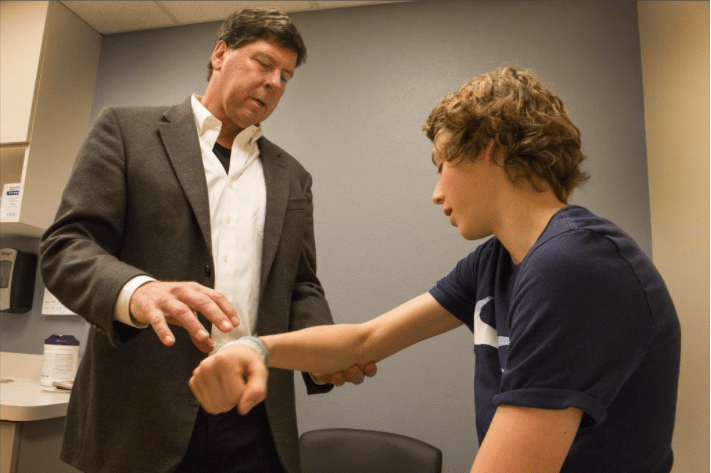
Elbow injuries are common work-related and sports-related injuries. Your elbow joint is made up of bone, cartilage, ligaments, and fluid. Muscles and tendons help the elbow joint move. When any of these structures is hurt or diseased, you have elbow problems. Elbow injuries can be acute or chronic and depending on the area of the elbow affected, it may be painful to move the elbow and straighten the arm.
What Causes Elbow Injuries?
Many things can make your elbow hurt. A common cause is tendonitis, inflammation or injury to the tendons that attach muscle to bone. Tendonitis often occurs as a result of repetitive stress.
Other injuries may be due to direct impact in sports, car accidents, or from daily activities like leaning on the elbow or from a fall.
What Are the Most Common Elbow Injuries?
Elbow pain can stem from many issues including:
- Arthritis
- Bursitis
- Dislocations
- Fractures
- Lacerations
- Nerve Damage (cubital tunnel syndrome)
- Sprains and Strains
- Tendinopathy (Tennis and Golfer’s Elbow)
- Torn Ligaments
When Should You Seek Emergency Care For An Elbow Injury?
You should seek emergency care for your elbow injury if you have an obvious deformity in your elbow or if you have a protruding bone.
When Should You See A Doctor for Elbow Pain?
You should see a doctor right away if you are having severe pain, swelling and bruising around the joint; or if you are having trouble moving your elbow normally, using your arm or turning your arm from palm up to palm down and vice versa.
If home care (as described below) is not helping after 72 hours, you should schedule an office visit with your doctor, especially if the pain is occurring even when you are not using your arm and you have redness, swelling, and pain in the injured area.
What Can You Do At Home?
If you have a minor injury, elbow pain resolves on its own with a little self-care treatment at home. Initially, protect the area from any further injury, then follow the RICE (Rest, Ice, Compression, Elevation) method to treat your injury.

How Do You Diagnose Elbow Injuries?
During your visit, your doctor may order an arthrography or a bone x-ray to diagnose your injury.
Arthrography is a type of medical imaging used to help evaluate and diagnose joint conditions and unexplained pain. Examples of arthrography include computed tomography (CT) scanning, magnetic resonance imaging (MRI), or fluoroscopy (x-ray imaging).
A bone x-ray uses a very small dose of ionizing radiation to produce pictures of any bone in the body. It is commonly used to diagnose fractured bones or joint dislocation.
How Do You Treat Elbow Injuries?
There are several treatment options available for your elbow injury, but treatment usually depends on the cause and severity of the injury. Treatment options may range from ice, compression and taping to sports massage, rehabilitation, and electrotherapy, to joint and soft tissue injections to surgery.
Contact Us
At Go To Ortho, we collectively have over 100 years of combined experience dealing with trauma injuries in the Portland area. Let Go To Ortho be your go-to place for quick-care orthopedic injury treatment.
Walk-in appointments are welcome. View our hours.



